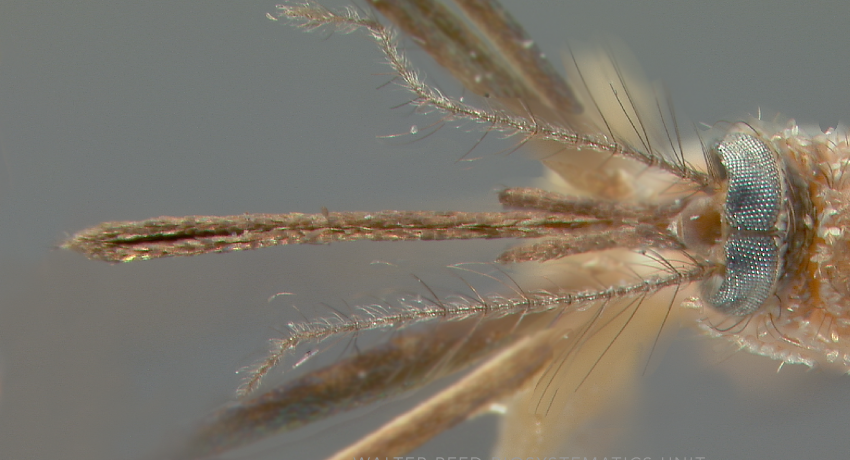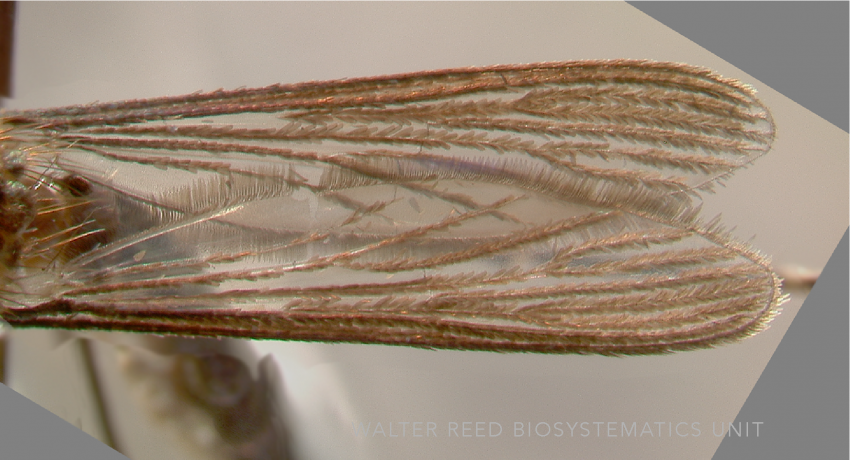NEOTROPICAL REGION
Generic abbreviation: Sh.
Type species: Goeldia fluviatilis Theobald
Etymology: Raymond Corbett Shannon
The genus Shannoniana comprises only three species—Shannoniana fluviatilis (Theobald), Sh. moralesi (Dyar & Knab) and Sh. schedocyclia (Dyar & Knab)—which are found only in Central and South America, from Mexico to Bolivia and Brazil. Shannoniana larvae have a prominent tooth-like process on both the maxillary body and maxillary claw—a character only shared with New World Isostomyia and Old World Tripteroides.
DIAGNOSTIC CHARACTERS (Click photos to view; mouse over and click large photo to zoom in.)
ADULT (illustrated): Head: Proboscis about as long as forefemur (Fe-I); palpus ≥0.3 x length of proboscis. Thorax: Lower mesokatepisternal setae extend above the level of edge of mesepimeron; postprocoxal scales present on postprocoxal membrane; scutellum without silvery scales. Legs: Ti-III with a broad median pale band. Abdomen: I-Te densely scaled laterally.
LARVA (not illustrated): Head: Occipital foramen circular with a distinct collar; maxilla modified for grasping; maxillary brush forming a claw; maxilla strongly articulated with head, ventrad of the palpus. Terminal segments: Accessory midventral setae of siphon absent.
TAXONOMIC KEYS
Lane 1953 (Neotropics)
Clark-Gil & Darsie 1983 (Guatemala)
![]()
WRBU – Genera – Global – Larva
![]()
WRBU – Genera – Neotropical – Adult
![]()
WRBU – Genera – Neotropical – Larva
Exemplar DNA sequences
Sh. fluviatilis COI: MF172380–84
Sh. schedocyclia COI: MF172378–79
BIONOMICS
Immatures
Shannoniana immatures are typically found in water collections in standing, broken bamboo and in the leaf axils of Araceae, and the larvae are both predacious and cannibalistic. Shannoniana moralesi larvae moves in an unusual way—attaching to vertical and horizontal substrates using its head, then pulling its body forward to direct propulsion—indicating that the larvae may move into fresh plant axils once their food resources have been depleted.
Adults
Members of the forest-associated species of Shannoniana are active during the day in the heavy shade of deep forest environments. Shannoniana fluviliatis females have been collected biting horses, at human bait, and in hand nets in a premontane forest in Antioquia, Colombia.
*Associated pathogens: This list reports bacteria, viruses, and parasites recovered from, or experimentally passed through this species, and does not imply field vector status.
IMPORTANT REFERENCES (full citations below)
Lane & Cerqueira 1942: 502 (as subg. of genus Trichoprosopon)
Lane 1953 (tax. review, keys; as subgenus of Trichoprosopon)
Zavortink 1979b: 11 (from subgenus of Trichoprosopon)
Clark-Gil & Darsie 1983 (keys; Guatemala)
Harbach & Peyton 1993 (L mouthparts, phylogeny)
Judd 1996 (phylogeny)
Harbach & Kitching 1998 (phylogeny)
Harbach & Peyton 2000 (phylogeny)
Harbach et al. 2007b (phylogeny)
VALID SUBGENERA
None
CURRENT GENERIC SYNONYMS
syn. Goeldia Theobald 1903a: 330 (not Goeldia Keyserling 1891). Type species: Goeldia fluviatilis Theobald.
CITED REFERENCES
Clark-Gil, S., & Darsie, Jnr., R.F. (1983). The mosquitoes of Guatemala: their identification, distribution and bionomics, with keys to adult females and larvae, in English and Spanish. Mosquito Systematics, 15(3), 151–284.
Harbach, R.E. & Kitching, I.J. (1998). Phylogeny and classification of the Culicidae (Diptera). Systematic Entomology, 23(4), 327–370.
Harbach, R.E., & Peyton, E.L. (1993). Morphology and evolution of the larval maxilla and its importance in the classification of the Sabethini (Diptera: Culicidae). Mosquito Systematics, 25(1), 1–16.
Harbach, R.E., & Peyton, E.L. (2000). Systematics of Onirion, a new genus of Sabethini (Diptera: Culicidae) from the Neotropical region. Bulletin of the Natural History Museum London (Entomology), 69, 115–159.
Harbach, R.E., Huong, V.E., & Kitching, I.J. (2007b). Systematics of Kimia, a new genus of Sabethini (Diptera: Culicidae) in the Oriental Region. Proceedings of the Entomological Society of Washington, 109(1), 102–120.
Judd, D.J. (1996). Review of the systematics and phylogenetic relationships of the Sabethini (Diptera: Culicidae). Systematic Entomology, 21(2), 129–150.
Lane, J. (1953). Neotropical Culicidae (Vols. I, II). São Paulo: University of São Paulo.
Lane, J., & Cerqueira, N.L. (1942). Os sabetineos da America (Diptera, Culicidae). Arquivos de Zoologia, São Paulo, 3, 473–849.
Theobald, F.V. (1903a). A monograph of the Culicidae of the World (Vol. 3). London: British Museum (Natural History). 359pp
Zavortink, T.J. (1979b). The new sabethine genus Johnbelkinia and A preliminary reclassification of the composite genus Trichoprosopon. Contributions of the American Entomological Institute, 17(1), 1–61.
CITE THIS PAGE
Walter Reed Biosystematics Unit (Year). Shannoniana genus page. Walter Reed Biosystematics Unit Website, http://wrbu.si.edu/vectorspecies/genera/shannoniana, accessed on [date (e.g. 03 February 2020) when you last viewed the site].







